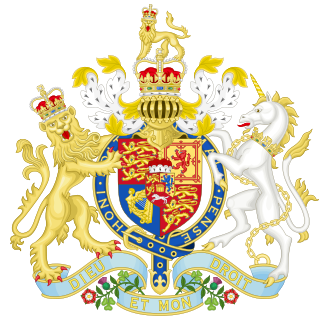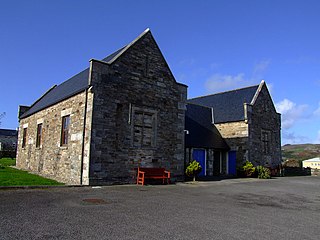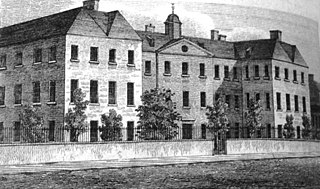
The English Poor Laws were a system of poor relief in England and Wales that developed out of the codification of late-medieval and Tudor-era laws in 1587–1598. The system continued until the modern welfare state emerged after the Second World War.

In Britain and Ireland, a workhouse was an institution where those unable to support themselves financially were offered accommodation and employment. The earliest known use of the term workhouse is from 1631, in an account by the mayor of Abingdon reporting that "we have erected wthn [sic] our borough a workhouse to set poorer people to work".
A poorhouse or workhouse is a government-run facility to support and provide housing for the dependent or needy.

The Poor Relief Act 1662 was an Act of the Cavalier Parliament of England. It was an Act for the Better Relief of the Poor of this Kingdom and is also known as the Settlement Act or the Settlement and Removal Act. The purpose of the Act was to establish the parish to which a person belonged, and hence clarify which parish was responsible for him should he become in need of Poor Relief. This was the first occasion when a document proving domicile became statutory: these were called "settlement certificates".
A vestry was a committee for the local secular and ecclesiastical government of a parish in England, Wales and some English colonies, which originally met in the vestry or sacristy of the parish church, and consequently became known colloquially as the "vestry". At their height, the vestries were the only form of local government in many places and spent nearly one-fifth of the budget of the British government. They were stripped of their secular functions in 1894 and were abolished in 1921.

The Poor Law Amendment Act 1834 (PLAA) known widely as the New Poor Law, was an Act of the Parliament of the United Kingdom passed by the Whig government of Earl Grey. It completely replaced earlier legislation based on the Poor Relief Act 1601 and attempted to fundamentally change the poverty relief system in England and Wales. It resulted from the 1832 Royal Commission into the Operation of the Poor Laws, which included Edwin Chadwick, John Bird Sumner and Nassau William Senior. Chadwick was dissatisfied with the law that resulted from his report. The Act was passed two years after the Representation of the People Act 1832 which extended the franchise to middle-class men. Some historians have argued that this was a major factor in the PLAA being passed.
A poor law union was a geographical territory, and early local government unit, in Great Britain and Ireland.

The Poor Relief Act 1601 was an Act of the Parliament of England. The Act for the Relief of the Poor 1601, popularly known as the Elizabethan Poor Law, "43rd Elizabeth" or the Old Poor Law was passed in 1601 and created a poor law system for England and Wales.
An overseer of the poor was an official who administered poor relief such as money, food, and clothing in England and various other countries which derived their law from England such as the United States.

The Relief of the Poor Act 1782, also known as Gilbert's Act, was a British poor relief law proposed by Thomas Gilbert which aimed to organise poor relief on a county basis, counties being organised into parishes which could set up poorhouses or workhouses between them. However, these workhouses were intended to help only the elderly, sick and orphaned, not the able-bodied poor. The sick, elderly and infirm were cared for in poorhouses whereas the able-bodied poor were provided with poor relief in their own homes. Gilbert's Act aimed to be more humane than the previous modification to the Poor Law, the Workhouse Test Act. During the 1780s, there was an increase in unemployment and underemployment due to high food prices, low wages and the effects of enclosing land. This caused poor rates to increase rapidly, which wealthy landowners found unacceptable.

In English and British history, poor relief refers to government and ecclesiastical action to relieve poverty. Over the centuries, various authorities have needed to decide whose poverty deserves relief and also who should bear the cost of helping the poor. Alongside ever-changing attitudes towards poverty, many methods have been attempted to answer these questions. Since the early 16th century legislation on poverty enacted by the Parliament of England, poor relief has developed from being little more than a systematic means of punishment into a complex system of government-funded support and protection, especially following the creation in the 1940s of the welfare state.
From the reign of Elizabeth I until the passage of the Poor Law Amendment Act 1834 relief of the poor in England was administered on the basis of a Poor Relief Act 1601. From the start of the nineteenth century the basic concept of providing poor relief was criticised as misguided by leading political economists and in southern agricultural counties the burden of poor-rates was felt to be excessive (especially where poor-rates were used to supplement low wages. Opposition to the Elizabethan Poor Law led to a Royal Commission on poor relief, which recommended that poor relief could not in the short term be abolished; however it should be curtailed, and administered on such terms that none but the desperate would claim it. Relief should only be administered in workhouses, whose inhabitants were to be confined, 'classified' and segregated. The Poor Law Amendment Act 1834 allowed these changes to be implemented by a Poor Law Commission largely unaccountable to Parliament. The act was passed by large majorities in Parliament, but the regime it was intended to bring about was denounced by its critics as un-Christian, un-English, unconstitutional, and impracticable for the great manufacturing districts of Northern England. The Act itself did not introduce the regime, but introduced a framework by which it might easily be brought in.
Boards of Guardians were ad hoc authorities that administered Poor Law in the United Kingdom from 1835 to 1930.

The Irish poor laws were a series of acts of Parliament intended to address social instability due to widespread and persistent poverty in Ireland. While some legislation had been introduced by the pre-Union Parliament of Ireland prior to the Act of Union, the most radical and comprehensive attempt was the Irish act of 1838, closely modelled on the English Poor Law Amendment Act 1834. In England, this replaced Elizabethan era legislation which had no equivalent in Ireland.
The Scottish poor laws were the statutes concerning poor relief passed in Scotland between 1579 and 1929. Scotland had a different poor law system to England and the workings of the Scottish laws differed greatly to the Poor Law Amendment Act 1834 which applied in England and Wales.
Poor Law policy after the New Poor Law concerns the time period c. 1847–1900 after the implementation of the Poor Law Amendment Act until the beginnings of the decline of the Poor Law system at the start of the 20th century.

The Poor Relief (Ireland) Act 1838 is an Act of the Parliament of the United Kingdom that created the system of poor relief in Ireland. The legislation was largely influenced by the English Poor Law Act of 1834.

The Scottish poorhouse, occasionally referred to as a workhouse, provided accommodation for the destitute and poor in Scotland. The term poorhouse was almost invariably used to describe the institutions in that country, as unlike the regime in their workhouse counterparts in neighbouring England and Wales residents were not usually required to labour in return for their upkeep.

The Poor Relief Act 1722, also known as the Workhouse Test Act 1722, Workhouse Test Act 1723 or Knatchbull's Act, was an Act of Parliament passed by the Parliament of Great Britain. It was titled "An Act for Amending the Laws relating to the Settlement, Employment, and Relief of the Poor".

The Lunacy (Scotland) Act 1857 formed mental health law in Scotland from 1857 until 1913.











